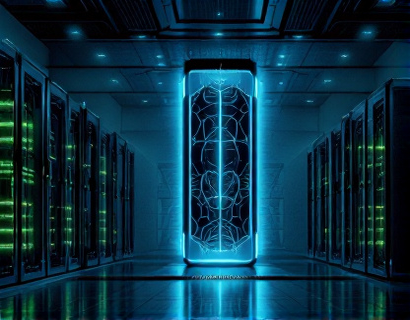Blockchain-Enabled Registry Software: Revolutionizing Data Management
In an era where data integrity, security, and efficiency are paramount, the integration of blockchain technology into registry management has emerged as a transformative solution. This article delves into the profound impact of blockchain-enabled registry software, highlighting its capabilities to enhance data management through unparalleled security, transparency, and efficiency. Whether you are a professional in data management, a technology enthusiast, or a advocate for data security, understanding the potential of blockchain in registry management is crucial for navigating the digital transformation landscape.
Understanding Blockchain Technology
Before exploring its application in registry management, it's essential to grasp the fundamentals of blockchain technology. At its core, a blockchain is a decentralized digital ledger that records transactions across multiple computers in such a way that the registered transactions cannot be altered retroactively. This technology ensures that once data is recorded, it is immutable and transparent, providing a high level of trust and security.
Blockchain operates on a network of nodes, each maintaining a copy of the entire ledger. Transactions are grouped into blocks, and each block is linked to the previous one through cryptographic hashes, forming a chain. This structure not only ensures the integrity of the data but also makes it extremely difficult for any single entity to manipulate the information without consensus from the majority of the network.
Enhancing Security in Registry Management
One of the most significant advantages of blockchain-enabled registry software is its ability to enhance security. Traditional registry systems are often centralized, making them vulnerable to cyber attacks, data breaches, and unauthorized access. In contrast, blockchain's decentralized nature distributes data across a network, reducing the risk of a single point of failure.
Each transaction in a blockchain is encrypted and verified through consensus mechanisms, such as proof of work or proof of stake. This cryptographic verification ensures that only valid transactions are added to the blockchain, making it nearly impossible for malicious actors to alter or tamper with the data. For professionals in data security, this means a robust defense against the ever-evolving threats in the cyber landscape.
Ensuring Transparency and Trust
Transparency is another cornerstone of blockchain technology, and it plays a vital role in building trust in registry management. In a blockchain-based system, all transactions are recorded on a public ledger that is accessible to all participants. This openness allows stakeholders to verify the authenticity and integrity of the data, fostering a higher level of trust among users.
For registry management professionals, this transparency is invaluable. It enables real-time tracking of data changes, audit trails, and compliance verification. Regulatory bodies can also benefit from this level of transparency, as it simplifies the process of monitoring and enforcing regulations. The immutable nature of blockchain ensures that once data is recorded, it cannot be altered, providing a reliable and trustworthy source of information.
Improving Efficiency and Streamlining Processes
Blockchain-enabled registry software not only enhances security and transparency but also significantly improves efficiency. Traditional registry processes often involve multiple intermediaries, manual data entry, and lengthy verification procedures, which can lead to delays and errors. Blockchain automates and streamlines these processes, reducing the need for intermediaries and minimizing human error.
Smart contracts, self-executing contracts with the terms directly written into code, can automate routine tasks such as data validation, consent management, and compliance checks. This automation not only speeds up the process but also ensures consistency and accuracy. For IT and software development teams, integrating smart contracts into registry management systems can lead to more efficient workflows and reduced operational costs.
Use Cases in Various Industries
The applications of blockchain-enabled registry software extend across various industries, each benefiting from the unique features of blockchain technology. In the healthcare sector, patient records can be securely and efficiently managed, ensuring that medical information is accurate, up-to-date, and accessible to authorized personnel. This can lead to better patient care and compliance with regulatory standards.
In the real estate industry, blockchain can streamline property transactions by providing a transparent and secure record of ownership, reducing fraud and disputes. For government and regulatory bodies, blockchain can enhance the management of public records, voting systems, and supply chain tracking, ensuring accountability and reducing corruption.
For business process optimization experts, blockchain-enabled registry software can revolutionize supply chain management by providing end-to-end visibility and traceability. This can help in identifying bottlenecks, reducing costs, and improving overall efficiency. Digital transformation leaders can leverage blockchain to drive innovation and stay ahead in a competitive market.
Challenges and Considerations
While the benefits of blockchain-enabled registry software are clear, there are also challenges and considerations that need to be addressed. One of the primary concerns is scalability. Current blockchain technologies, particularly public blockchains, can face performance issues when handling a large volume of transactions. However, advancements in blockchain architecture, such as sharding and layer 2 solutions, are addressing these scalability challenges.
Another consideration is the regulatory landscape. As blockchain technology is still relatively new, regulatory frameworks are evolving. Organizations must stay informed about local and international regulations to ensure compliance. Additionally, the integration of blockchain into existing systems requires careful planning and expertise to avoid disruptions and ensure seamless operation.
Future Prospects and Innovations
The future of blockchain-enabled registry software looks promising, with ongoing innovations set to further enhance its capabilities. Interoperability between different blockchain platforms is becoming a focus, allowing for more seamless integration and data sharing across various systems. This interoperability can lead to more comprehensive and cohesive registry solutions.
Furthermore, the development of private and consortium blockchains is addressing some of the scalability and privacy concerns associated with public blockchains. These tailored solutions offer a balance between decentralization and performance, making them suitable for enterprise-level applications.
As the technology matures, we can expect to see more widespread adoption across industries, driven by the compelling benefits of security, transparency, and efficiency. For professionals and enthusiasts in the field, staying informed and proactive in embracing these innovations will be key to success in the digital transformation era.
Conclusion
Blockchain-enabled registry software represents a significant leap forward in data management, offering unparalleled security, transparency, and efficiency. By leveraging the inherent strengths of blockchain technology, organizations can streamline processes, build trust, and stay competitive in a rapidly evolving digital landscape. Whether you are a seasoned professional or a curious enthusiast, the potential of blockchain in registry management is a transformative force worth exploring.










































